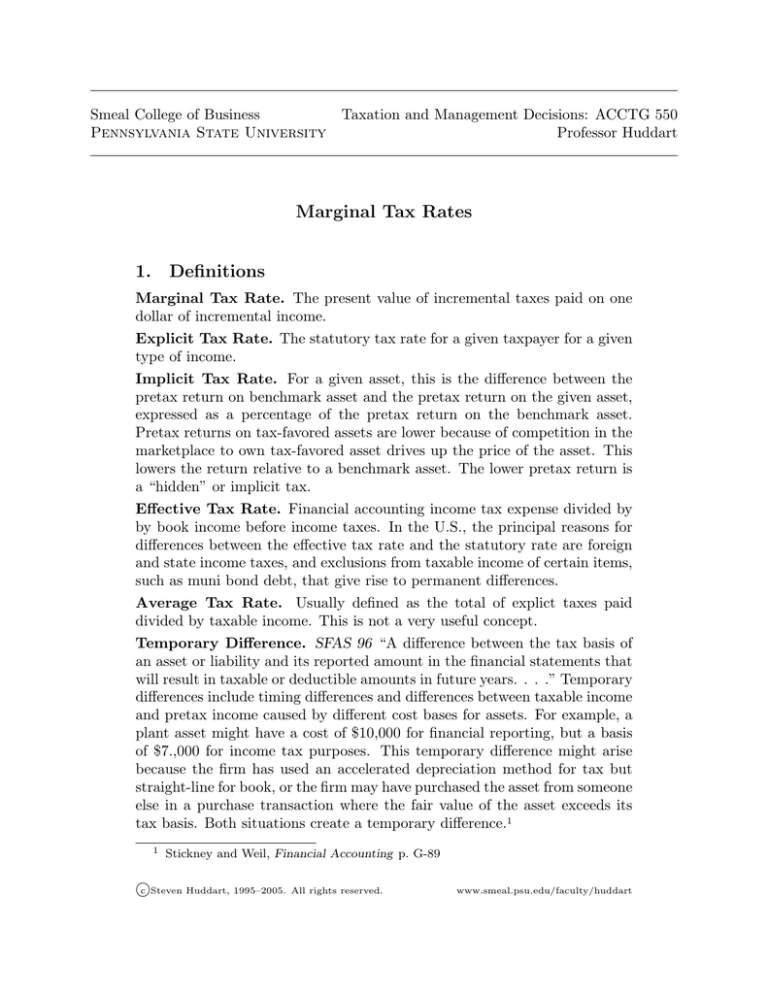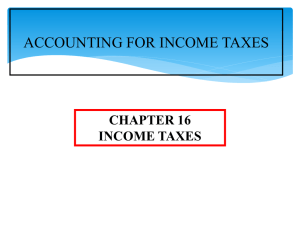
Smeal College of Business
Pennsylvania State University
Taxation and Management Decisions: ACCTG 550
Professor Huddart
Marginal Tax Rates
1.
Definitions
Marginal Tax Rate. The present value of incremental taxes paid on one
dollar of incremental income.
Explicit Tax Rate. The statutory tax rate for a given taxpayer for a given
type of income.
Implicit Tax Rate. For a given asset, this is the difference between the
pretax return on benchmark asset and the pretax return on the given asset,
expressed as a percentage of the pretax return on the benchmark asset.
Pretax returns on tax-favored assets are lower because of competition in the
marketplace to own tax-favored asset drives up the price of the asset. This
lowers the return relative to a benchmark asset. The lower pretax return is
a “hidden” or implicit tax.
Effective Tax Rate. Financial accounting income tax expense divided by
by book income before income taxes. In the U.S., the principal reasons for
differences between the effective tax rate and the statutory rate are foreign
and state income taxes, and exclusions from taxable income of certain items,
such as muni bond debt, that give rise to permanent differences.
Average Tax Rate. Usually defined as the total of explict taxes paid
divided by taxable income. This is not a very useful concept.
Temporary Difference. SFAS 96 “A difference between the tax basis of
an asset or liability and its reported amount in the financial statements that
will result in taxable or deductible amounts in future years. . . .” Temporary
differences include timing differences and differences between taxable income
and pretax income caused by different cost bases for assets. For example, a
plant asset might have a cost of $10,000 for financial reporting, but a basis
of $7.,000 for income tax purposes. This temporary difference might arise
because the firm has used an accelerated depreciation method for tax but
straight-line for book, or the firm may have purchased the asset from someone
else in a purchase transaction where the fair value of the asset exceeds its
tax basis. Both situations create a temporary difference.1
1
Stickney and Weil, Financial Accounting p. G-89
c Steven Huddart, 1995–2005.
All rights reserved.
www.smeal.psu.edu/faculty/huddart
ACCTG 550
Marginal Tax Rates
• Other examples of transactions giving rise temporary differences include:
– depreciation
– installment sales
– bad debts
Permanent Difference. Difference between reported income and taxable
income that will never be reversed and, hence, requires no entry in the
deferred income tax liability account. An example is the difference between
taxable and reportable income from interest earned on state and municipal
bonds.2
• Other examples of transactions giving rise permanent differences include:
– fines
– life insurance premia
Deferred Income Tax Liability. An indeterminate term liability that
arises when the pretax income shown on the tax return is less than what
it would have been had the same accounting principles and cost basis for
assets and liabilities been used in tax returns as used for financial reporting.
SFAS 109 requires that the firm debit income tax expense and credit
deferred income tax with the amount of the taxes delayed by using different
accounting principles in tax returns from those used in financial reports. . .
. If as a result of temporary differences, cumulative taxable income exceeds
cumulative reported income before taxes, the deferred income tax account
will have a debit balance and will be reported as a deferred charge.3
2.
Financial accounting for taxes
• Not all countries employ deferred tax accounting. In Germany and
France, for example, book income is taxable income (with few exceptions), so temporary differences do not arise.
• UK GAAP discounts future tax obligations
• In the US, deferred taxes are not discounted. This has the effect of
overstating the effective tax rate disclosed in the financial statements.
2
3
Stickney and Weil, Financial Accounting p. G-67
Stickney and Weil, Financial Accounting p. G-29
Page 2
Marginal Tax Rates
ACCTG 550
• In the US, the recognition of deferred tax charges is subject to an
assumption about the likelihood the firm will produce taxable income
sufficient to offset the charges.
• How does US GAAP record prepare information on tax rates?
– average, not marginal basis
– mistreats implicit taxes
– permanent difference (e.g., municipal bond interest, goodwill, dividend received deduction) versus timing differences (e.g., depreciation)
– no discounting of future tax obligations
– rigid concept of uncertainty. SFAS 109 requires all tax assets and
liabilities to be recorded however, a valuation account (like an
allowance for bad debts) applies against tax assets based on a “more
certain than not” criterion for realization.
– existence of an audit cushion–better to have set aside too much tax
expense than too little–a bias toward conservatism
3.
GAAP Reporting versus Tax Reporting
Recently, SEC accountants have been asking corporations filing 10Ks to
explain how they have accounted for purchased goodwill for tax purposes.
To keep earnings high, companies amortize goodwill over 40 years. For tax
purposes, some of these same companies had allocated goodwill to deductible
purchased intangibles like custormer lists that can be amortized against
income over short periods (e.g., 3 years). Goodwill accounting for financial
statement purposes has not had to mirror tax accounting for intangibles in
the past. However, the recent concern by the SEC has tended to bring tax
and 10K disclosures closer together. There is a tradeoff between increasing
after-tax cash flow and increasing current accounting earnings whenever tax
treatment must resemble accounting treatment.
There is also some academic research that suggests tax preparers are
swayed by the financial accounting treatment accorded to a transaction
in recommending an appropriate treatement for tax purposes. See Bryan
Cloyd’s work in the Journal of the American Tax Association.
Page 3




